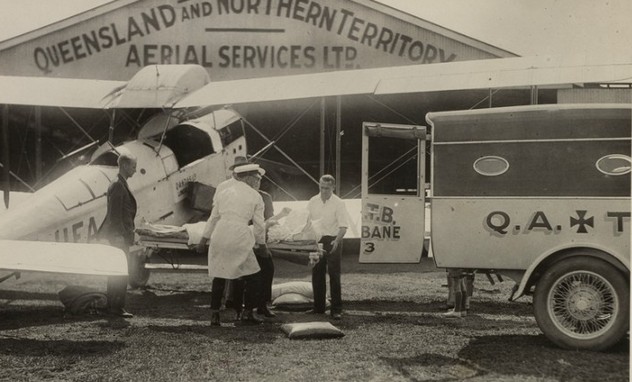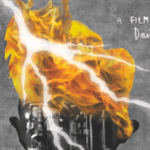 Mysteries
Mysteries  Mysteries
Mysteries  Our World
Our World 10 Extraordinary Efforts to Stop Pollution
 Our World
Our World 10 Incredible Discoveries That Were Announced This Year
 History
History 10 Historical Figures You Didn’t Know Had Tattoos
 Food
Food 10 Head-Scratching Food Fads That Have (Mostly) Come and Gone
 Movies and TV
Movies and TV 10 Sequels That Simply Repeat the First Film
 Technology
Technology 10 Surprising Stories Made Possible by Cutting-Edge Technology
 Animals
Animals 10 Popular Misconceptions about Dogs
 History
History 10 Unbelievably Badass Women from History
 Music
Music 10 Rock Musicians with Impressive College Degrees
 Mysteries
Mysteries 10 Human Capabilities That Scientists Don’t Understand
 Our World
Our World 10 Extraordinary Efforts to Stop Pollution
 Our World
Our World 10 Incredible Discoveries That Were Announced This Year
Who's Behind Listverse?

Jamie Frater
Head Editor
Jamie founded Listverse due to an insatiable desire to share fascinating, obscure, and bizarre facts. He has been a guest speaker on numerous national radio and television stations and is a five time published author.
More About Us History
History 10 Historical Figures You Didn’t Know Had Tattoos
 Food
Food 10 Head-Scratching Food Fads That Have (Mostly) Come and Gone
 Movies and TV
Movies and TV 10 Sequels That Simply Repeat the First Film
 Technology
Technology 10 Surprising Stories Made Possible by Cutting-Edge Technology
 Animals
Animals 10 Popular Misconceptions about Dogs
 History
History 10 Unbelievably Badass Women from History
 Music
Music 10 Rock Musicians with Impressive College Degrees
10 Lost Films We’ve Finally Found
There are countless lost films. It’s estimated that 70 percent of films from the silent era have disappeared. Whether lost in fires due to their highly flammable material or just thrown away, they are treasures we will never recover. Even modern films slip between the cracks for a variety of reasons. Occasionally, though, a copy of a film that the world thought was gone forever surfaces, and its story is brought back to life.
10The Day The Clown Cried
Jerry Lewis once made a film called The Day the Clown Cried. The film was never released but still became a hot topic among movie buffs. It tells the story of a German clown who is forced to lead Jewish children to the gas chamber after he mocks Hitler. One actor who saw it said it was “drastically wrong.” Lewis himself said that people would think it was either “better than Citizen Kane or the worst piece of s—t that anyone ever loaded on the projector.” After spending hours editing the film, Lewis decided that it was too bad to release. He scrapped every copy and repeatedly claimed that the world would never see it.
With so much talk about it, though, the film generated a lot of interest. Many have searched for The Day the Clown Cried to no avail, but eventually, the Library of Congress managed to get a copy. It became part of their Jerry Lewis collection. Despite obtaining the fabled film, the library made a deal with Lewis that it would only show the movie after 10 years, in 2025. Lewis, 89 years old at the time of this writing, will probably be spared the reaction to what he considers his greatest artistic failure unless he lives to be 99.
9Black Angel
Moviegoers in England, Scotland, and Australia might be familiar with Black Angel, which was shown as a precursor to The Empire Strikes Back. The rest of the world, however, has likely never heard of the lost film. Roger Christian, the set director for Star Wars, made a short fantasy movie about a medieval knight who fought evil for a young girl’s soul. George Lucas liked it, and since movies overseas had opening acts at the time, he commissioned Black Angel to be shown before The Empire Strikes Back.
In time, the original negatives were lost. Since anything that could still be produced would be substandard, the director decided to forget about the movie. It remained dead for many years until a clean copy was eventually rediscovered. The film was restored, but it never generated any interest. Only recently was it uploaded to YouTube for free, where it has garnered a large fan base. It’s gained enough momentum for Christian to begin remaking it into a feature-length film. He’s raising $15 million to cover the costs. There’s even an Indiegogo campaign where fans can pay for the chance to win a spot in the film’s undead army.
8Victory Of Faith
Victory of Faith is a propaganda film made by the Nazi party. It documents the first party rally after the Nazis rose to power in Germany, with half a million attendees. The film was made by a famed German director and is heralded for its innovative camera angles and editing, with a score by one of the Third Reich’s leading composers. But despite being such a cinematic accomplishment, the film was lost after Hitler himself ordered every copy destroyed.
Second only to Hilter in the rally was Ernst Rohm, who would later be personally arrested by Hitler and shot for planning a coup on the infamous Night of the Long Knives. Rohm figures prominently in the film. At one point, he’s the only person on the platform with the Nazi leader. Because the two were shown on such intimate terms, Hitler ordered the record of their camaraderie erased.
Fortunately, before the purge of Hitler’s in-house enemies, the filmmaker, famed for her documentaries, visited Great Britain to speak about her techniques at several major universities. During her trip, at least one copy of Victory of Faith was made. The copy had remained in storage for over 60 years before it was rediscovered in 1990. It has since been called an important tool in understanding the Nazi party at the early stages of its development.
7The Flying Doctor

In the Australian silent film industry, it was easy for films to be lost or rearranged. Since there was no soundtrack, films could be spliced together without a break in continuity. In one such case, a copy of the Kelly Gang that had footage from three versions of the story made it into circulation. The industry didn’t value old films, so there was little oversight about how they were handled. Several passed into the hands of private individuals and from there into occasionally odd places.
One movie was found behind the switchboard of an old Tasmanian theater. Another roll was found in a can schoolboys were using as a soccer ball. One of the most interesting finds, however, was made in the Sydney suburb of Figtree. While clearing a building site, workers found a steel-doored vault of a demolished film studio. Not knowing what they had, they cut the door open with a blowtorch.
The first miracle was that the highly flammable film did not ignite. The second happened when the crew was driving the old films to the local dump. A council employee happened to notice the reels and chased down the truck to rescue the possibly important old footage. Among the films, they found the only copy of The Flying Doctor, a love story about the Royal Flying Doctor Service of Australia. But unfortunately, the last reel was missing, leaving the plot unresolved. The third miracle came when a routine check of the National Film Archive in London came up with a master copy, but the British copy had been drastically edited and rearranged. The last reel of the edited version, however, picked up exactly where the incomplete Australian version left off.
6The First Frankenstein
The first Frankenstein film was shot in 1910 at Edison Studios. At 12 minutes long, it was one of the major films of its day. During the earliest days of cinema, films were usually shot in a single day, but likely due to the makeup and special effects, three days were devoted to the first incarnation of Frankenstein.
The monster’s wild hair and bandaged limbs were a very different image from the monster we know now. But while the monster’s appearance was probably closer to the novel than the green-skinned giant Universal Studios made famous, its story was a large departure from the original. In the film, the monster is literally cooked up in a boiler, and it disappears in the last “mirror scene” where Frankenstein sees the monster’s reflection as his own.
Like many of Edison’s films, copies were distributed in a circuit and then returned to Edison’s lab and destroyed so their silver content could be recycled. But after a copy of the 1910 The Edison Kinetogram magazine was discovered with a picture of the first Frankenstein, it became the world’s most sought-after lost film. Soon, Alois F. Dettlaff, a collector and archivist, revealed that he owned a complete print.
It was great that a copy existed, but many accused Dettlaff of hoarding it. The archivist proved himself to be somewhat off when he then started circulating the film with proprietary markings on the screen and lobbying for an Oscar in recognition for his work in “saving” the film. Dettlaff died alone in 2005, without an Oscar.
5Moe’s Books Party
A scavenger at a California dump found a tape reel labeled “New Mo Cut.” Opening it up, he found images of the owner of a popular bookstore “Moe’s Books” attending a party there. The scavenger was a regular customer at Moe’s, and since Moe himself was deceased, he thought it would make a nice gift for Moe’s daughter.
The film was a recording of one of Moe’s famous parties. Moe had been an actor before becoming a bookseller, and his parties were about sharing opinions on anything from politics to art. In the film, he rides up on a vintage Rolls-Royce wearing a topcoat and cloak and smoking a cigar. It switches to scenes of the party, where Moe serves champagne to his guests and gives a toast, likely to Humphrey Bogart. It was a short film with a sometimes shaky camera, but it had been edited and felt complete.
Moe’s daughter put it up on Moe’s Facebook page. Another book dealer saw it and mailed a friend who had lived in the area around the time of the filming, John Levy. Levy immediately recognized the film as being shot by David Peoples, the Academy Award–nominated screenwriter who would later go on to pen Unforgiven and Blade Runner. Peoples was just starting out in the film business when he shot the footage.
The streets of Berkeley, California in the 1960s were often crowded with protesters. Peoples made films wherever he could, shooting documentaries and news footage all over the area. He had been rejected from film school and was volunteering at a local news company. He’d kept a lot of his old films after becoming a screenwriter, but after the storage fees started to mount, he gave some away to universities and simply trashed some others. Tossing Moe’s party had been a mix-up, since he’d planned to keep that particular reel. But this turned out to be good news for Moe’s daughter, who got to see her father in his prime again.
4The First Snow White
The first Snow White film was released in 1916. It was an adaptation of a successful theatrical performance popular a few years prior. The version was very different from the Snow White made popular by Disney, as the theater had taken many liberties with the script. The film was released as a Christmas special by Paramount Pictures, the first of their films to use six reels instead of the standard five.
Walt Disney saw it in 1917 at a movie party. Snow White had such an impact on him that he would later make the famous version we know today. But aside from being the film that inspired Walt Disney’s famous animation, it was perhaps more importantly one of the lost films of Marguerite Clark. Clark was lauded as one of the greatest actresses of the silent age. One critic said that not seeing her was “like saying you have never seen a silver birch or a daffodil.” But almost her entire career literally disappeared in a puff of smoke when a vault fire in Paramount’s storage destroyed the negatives of every single one of her Paramount films. Fortunately for posterity, aside from Snow White, two of Clark’s other films have also been preserved. Unfortunately, the other 37 remain lost.
3The Very First Anime
Japan’s oldest anime was thought to be Imokawa Mukuzo Genkanban no Maki, which premiered in 1917. The film is well documented but remains lost. The second oldest commercial anime, however, was found at an antiques fair in 2008 in nearly perfect condition. Named Namakura Gatana, it was released shortly after Imokawa Mukuzo. It is a short comedy about a samurai who tries out a new sword only to find that he can’t remove it from its scabbard. While he struggles to pull it out, his target, an old man, kicks him away into the distance.
Even more recently, another film was found that predates what were once considered the earliest of Japan’s animations. The first anime ever created was found in Kyoto, in an old family projector among a collection of foreign animations. Possibly predating the first commercial releases by 10 years, it depicts a young boy in a sailor suit writing on a blackboard and then turning to salute the viewer. Only three seconds long, the animation was hand-drawn on the celluloid in red and black. The creator is unknown but was probably wealthy, since only the rich could afford projectors at that time. They also likely didn’t know they had created the first anime in history.
2The Grim Game
The Grim Game was reportedly Harry Houdini’s greatest film but became another victim of our inability to properly store the oldest films. Then one day, Rick Schmidlin, a film restorer for Turner Classic Movies (TCM), stopped by to see Houdini’s museum in Pennsylvania. While he was there, the proprietors told him an interesting story: They claimed that their friend Larry Weeks, who called himself “Houdini’s biggest fan,” actually had a copy of the legendary film. Unfortunately, Weeks was also hoarding it. He gave only a few screenings of the film, the largest of which was a semiprivate one at Manhattan’s New School. Weeks had received many offers for the film but turned down each and every one. Schmidlin asked the couple to help arrange a meeting with Weeks.
Weeks showed Schmidlin the film but refused to part with it until Schmidlin chatted him up about how TCM was associated with Warner Bros. Weeks was impressed enough to part with his most valued possession. After signing a contract for an undisclosed amount, what Weeks handed over was a complete copy of Houdini’s famous film in excellent condition. Luckily for Houdini lovers, the deal proved to be perfectly timed, since Weeks departed not long after selling the film. Had Schmidlin not heard about the film, it likely would have been lost forever.
1German Concentration Camps Factual Survey
This film shows Nazi SS soldiers carrying the bodies of victims they have murdered at concentration camps, tossing them into trucks and pits. Long, unending shots of emaciated corpses and crushed skulls, as well as every horror of Nazi concentration camps were on display in German Concentration Camps Factual Survey. The film is difficult to watch. But despite being the most impactful of the Holocaust films, it was never seen by audiences.
Sidney Bernstein produced the film and asked Alfred Hitchcock, a personal friend, to be the supervision director to lend it some star power. Hitchcock edited the film. Its long, panning shots were his idea—they helped to prove the scenes were real. Hitchcock also made sure to depict just how close the camps were to Germany’s picturesque villages, where life was going on as usual. One of the most poignant images that contrasted death with daily life was that of an off-duty soldier having a romantic rendezvous in one of the villages while thousands are mechanically slaughtered nearby. But Bernstein’s film soon became less of a propaganda film and more of a documentary. More importantly, it was taking too long. The American government hired another director to make a shorter film. The resulting Death Mills had a screening with 500 people in the audience. Less than 100 made it through to the end.
Meanwhile, Bernstein still hadn’t completed his film. And by that time, American and British policy for Germany was to rebuild the country, not to blame it. Factual Survey was swept under the table. It was never finished and set on a shelf to be forgotten. Yet, even though it had gotten lost in a web of politics, the Imperial War Museum recently recognized the film’s importance and set to work on restoring it. The documentary is now complete and was screened to a small number of audiences this year. HBO did a documentary about the film, and a larger release of Factual Survey is planned for the near future.
Nathan keeps a Japan blog where he writes about the sights, expat life, and finds Japanese culture in everyday items. You can also find him on Facebook and Twitter.








